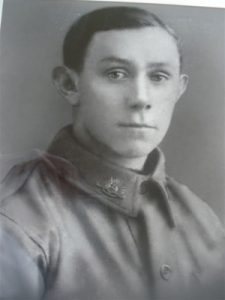 By John McNamee
By John McNamee
THERE is a certain sadness in the eyes…but yet they burn fiercely, proudly as he poses in his newly allocated but ill-fitting Australian army uniform.
His haunting gaze has followed generations of lifesavers around the dusty, draughty old surf club hall as they went about their duties, attended their innumerable meetings and celebrated noisily after many a surf carnival.
His photograph holds pride of place on the wall among the legendary club champions of yesteryear but unlike these surf icons, we knew little of the life and tragic death of this real-life hero….whose body has been lying in a soldiers’s grave at Gallipoli for the past 95 years.
He would have been one of the youthful pioneers of the fledgling surf lifesaving movement back in the first decades of the 20th century when he joined the then Little Coogee (now Clovelly) Life Saving club back around 1904/1905.
One of the many courageous young surf lifesavers who answered their country’s call to arms.
All we knew about him was the caption under the portrait…Sapper F L Wells, Killed In Action, Dardanelles, July 12, 1915.
His name is also featured on the club Honour Roll among his comrades in arms and others who gave the ultimate sacrifice in two World Wars.
But what did we know of this once fellow surf club member, and possible war hero, who leaves us such a terribly sad legacy?
It wasn’t until I started researching the Gallipoli campaign and its surf lifesaving connection for our major story for this edition of Go55s, that I was able to find out more about the brave young soldier, whose wistful eyes have now unveiled some of their secrets.
Francis (Frank to his mates) Leslie Wells, heeded the call to arms and enlisted in the Australian Army on August 21, 1914, soon after the outbreak of war.
He was aged 21.
The promising young civil engineer was the only son of Alfred and Florence Wells, of the then Hotel Victoria in Crown St Surry Hills, Sydney, and later of 79 Castlereagh St.
Because of his high qualifications, he was enrolled in the 1st Field Company, Australian Engineers.
During his initial training, the high-spirited young private, later to be gazetted Sapper, got into a few scrapes while in barracks and served several punishments for being “late on parade” .
His army record reveals that he stood 5’ 7” (170cm) tall, and weighed 9 stone 2 llbs (58 kilos).
He was a devout Roman Catholic.
After his training period, Sapper Frank Wells was despatched to the war front on one of the crowded troop ships and arrived in Alexandria, Egypt, on March 3, 1915 as part of the Expeditionary Force.
Two months after setting foot on the Gallipoli Peninsula, the young engineer fell victim to the dreaded dysentery which, along with the carnage in the trenches, was decimating the ANZAC troops.
Suffering a severe bout of the rampant bowel infection, Frank Wells was admitted to hospital on May 9 and wasn’t released until June 27, 1915.
But he wasn’t repatriated home after such a debilitating and body-sapping illness …. it wasn’t long before he was back in the hellish dugouts being constantly bombarded by the relentless Turkish machine gunners and artillery.
According to retired Colonel Graham Fleeton, of Military History Tours, as a sapper, Frank Wells would have been involved in laying landmines along the battlefield, stringing out the barbed wire across the trenches and generally being in the forefront as the bullets and shells ripped across the killing fields.
“It would have been hell for him and his comrades, he would also have been involved in making the crude grenade-like bombs that were used back then which were little more than jam tins with explosives and wicks in them and which caused horrific injuries at close range,” Mr Fleeton told Go55s.
During this time, Frank Wells was “mentioned in despatches” for a conspicuous act of bravery.
But a little more than two weeks after returning to the battlefield from his hospital bed, the young Clovelly lifesaver was fatally wounded in action around Quinns Post by one of the fiendish home-made bombs on July 12, 1915.
The official report states that he received severe shrapnel wounds to his neck and chest resulting in death.
He had just turned 22.
His comrades later buried his remains in the cemetery at Shrapnel Valley, where he still lies today.
Some months later his mother Florence received his effects. There was a small identity card, a damaged watch, a small family photograph In a picture frame, some coins … and a crucifix.
Later after the war, Frank Wells’ family were informed that he had been awarded posthumously the British War Medal, the 1914-1918 Star and the Victory Medal.
Ten years after the guns of the Great War fell silent, Florence Wells received a photograph of Frank’s burial plaque on top of his grave…….
These days, as I enter the dimly-lit downstairs hall of our century-old surf club, l look over to the wall of photographs and see those sad eyes fixed on mine.
“Rest in Peace for eternity and thank you Frank Wells, we are proud of you mate,” I whisper.


1 Comment
Howdy fantastic blog! Does running a blog like tthis requiure a massive amount work?
I’ve virtually no expertise in programming buut I had been hoping
to start my own blog soon. Anyways, should you have
any ides oor tips for neww blog owners please share.
I know this is off subject however I simply wanted to
ask. Thaanks a lot!